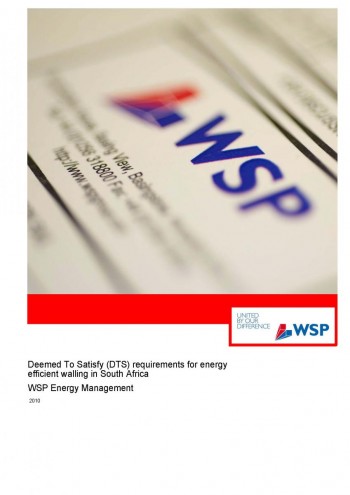Thermal Performance of walling in SA - SANS204
Edition 1 of the SANS 204 series of standards contains Deemed-to-satisfy (DTS) requirements that make a distinction between walls based on minimum “surface density”, requirements, quantified as “kg/m2”. The DTS requirements are in terms of minimum thermal resistance values (R-values), which should apply in each of six geographic regions.
The concerns about these provisions are as follows: that the scope of the current requirements excludes the majority of occupancy types, “surface density” is a rough approximation of thermal mass and is not scientifically determined, and that the minimum R values were determined through processes described by the researchers as “sub-optimal”, in that they were borrowed from the Building Code of Australia without an
optimisation check. The Clay Brick Association (CBA) has commissioned work to address these concerns.
Research study
The first part of this further research resulted in the proposed Edition 2 of the SANS 204 series containing a more comprehensive set of DTS requirements, as well as notes and guides. The second, and more substantial, part of the research has resulted in the following proposal for DTS requirements for external walling in South Africa (for an abbreviated description of the research outcomes and methodology see the Executive
Summary forwarded to SC59G).
The research has produced a more scientifically accurate and optimal approach whereby DTS requirements can be expressed in terms of minimum thermal capacity and thermal resistance (CR) product values.
The CR product requirements are developed from minimum Life Cycle Cost evaluations, after determination of the lowest energy consumption results for a series of buildings of different occupancy class in six climatic regions of South Africa.
Applying the proposed set of deemed to satisfy requirements for external walls will ensure, given other energy efficiency interventions in the building as per SANS 204, that the energy consumed by environmental controls of the building will be at levels required by the Department of Energy, in support of the 2015 energy reduction targets set out in the RSA Energy Strategy.
After a process of critical peer review, this research culminated in the final report dated 1 March 2010.
Research study authors
This work was carried by WSP Energy Africa in conjunction with Professor Dieter Holm as specialist consultant, and resulted in a recommendation that a table of minimum CR values be adopted into the standard. Any wall system would, therefore, have to achieve said values to be deemed-to-satisfy. A further recommendation was that should wall systems with low thermal capacity and / or thermal resistance be selected for a building design, then such a design should be subjected to a rational approach by a competent person.
The WSP report was reviewed by the members of the SABS Steering Committee 59G and was accepted as the basis for a table of deemed-to satisfy CR product requirements for walling systems of surface density greater than 180kg/m2. This was to allow walling systems of less density, typically of low thermal capacity and higher thermal resistance, to also be deemed-to-satisfy. The Clay Brick Association noted the concern of the committee with this situation as the research showed that walls should contain minimum levels of both thermal capacity and resistance if energy efficiency goals are to be achieved.
In order to quantify this concern, the Clay Brick Association has extended the research project to include some further modelling of the same building designs which were developed in the research process, with three alternative low mass / surface density walling systems.

